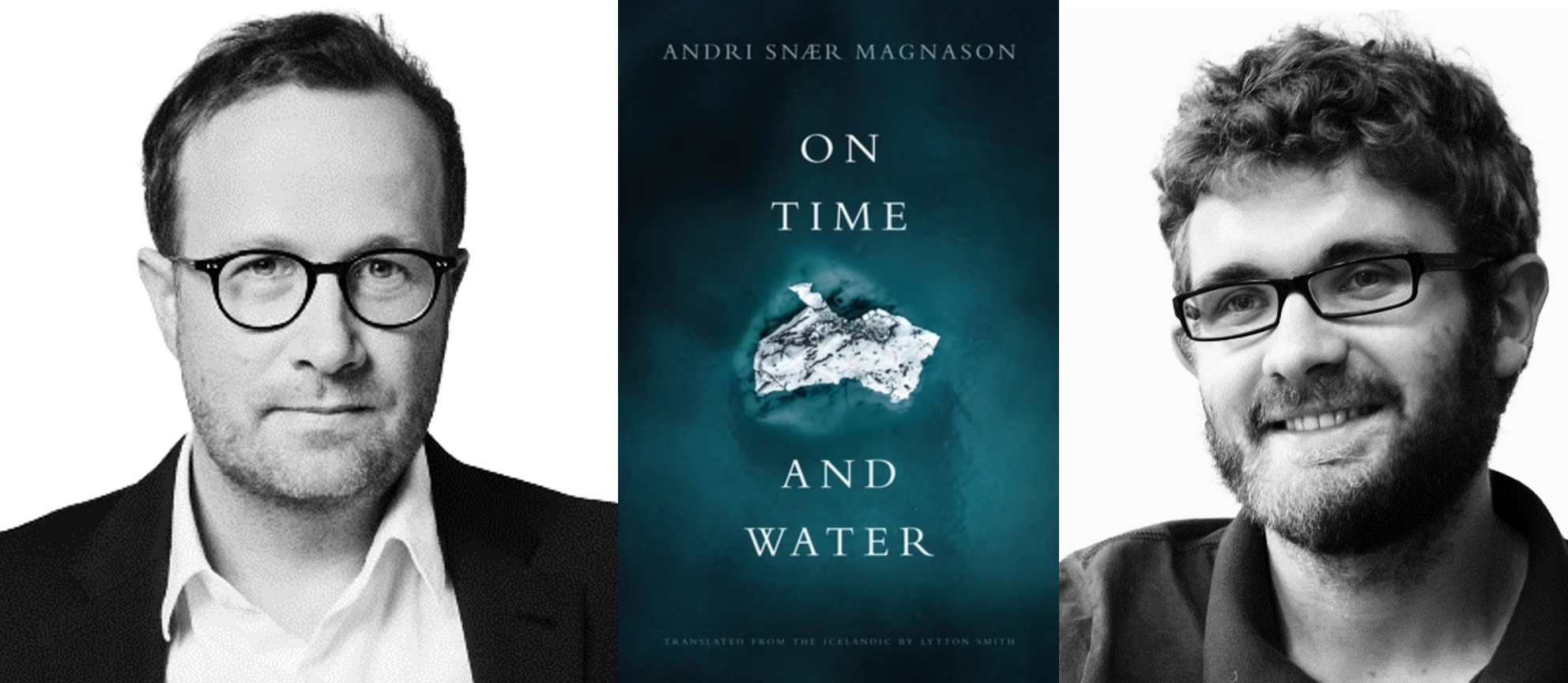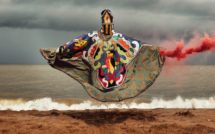

Translated from the Icelandic by Lytton Smith.
I went out to the Kringilsárrani reserve while it still existed and was able to experience firsthand this magical world Helgi wrote about. To walk through this valley of animals alongside the Jökulsá riverbed; to see goose nests amid the columnar basalt walls that formed the gorge’s sides; to stand on the lava-red bedrock as the gushing glacial river surged over the falls of Raudaflúd—it was incomparable. How mes-merizing it was, watching the river break through a narrow crevasse and practically dissolve into a thundering torrent that flung rocks uphill, like some uncontrollable eruption, a formless disorder. A falcon hovered high above me. I found the lone rock standing on a fragile foundation, humanoid in shape, like a troll or Darth Vader’s head. This rock had become symbolic of the area and it did not feel like any of the other rocks in the area. Even though I’d come in peace, I felt it was displeased by my presence.
I would never have dared speak my mind the way Helgi had, would never dare write something in his style: “There at Töfrafoss, my soul’s harp strings vibrated while the Creator thrummed Kringilsá’s burgeoning bass . . .” If I’d used this kind of language in Dreamland, I’d have been written off. I would have been held up as the archetype for some modern, New Age, urban hipster nonsense. I’d found myself overwhelmed by melancholy at the unruly devastation that washed out this peerless region, yet I chose words that seemed moderate and inviting to readers. I used the prevailing language of liberal-ism, innovation, utilitarianism, and marketing. I discussed the area’s importance for Iceland’s image, its potential tourist income, the area’s research value, how the highlands were a magnet for foreign currency as a filming location for movies or commercials. Movies create an experience, but the image of a landscape can’t replace a visit to the location. We live in times when money is the measure of reality. I couldn’t argue nature’s right to exist, its essential value, by saying that we might find God’s all-encompassing expanse there.
This dispute over the Icelandic highlands flipped logical arguments on their heads. Instead of an area’s untouched quality being taken as proof of its value and significance, that fact was turned against the region; as a result, it was branded “unpopular.” Nature needed high enough “ratings,” went the argument, people looking at it or using it, building hotels or gas stations or hamburger joints, bringing tour buses and guides. You had to be able to use nature, in some way, even if only as the backdrop for a car commercial. Nothing is allowed to have an undefined purpose; everything must be quantifiable, regardless of whether the metrics match the reality or not. The power to define reality and to discuss the value of nature belongs to economics.
Politicians talked down the region, saying it was noth-ing special. The farmers who “owned” the land went to the papers and sounded off about how the area really wasn’t particularly remarkable, how it was primarily city folk who were losing their minds over the situation: “To be honest, I’d be happy not to have to go all the way up there into the ravines to round up the sheep each year.”
I was part of the crowd arguing that the area had an excel-lent case for status as a national park, but I was often held up as an example of a modern urbanite experiencing nature for the first time. Similarly, photographers were accused of exaggerating its natural beauty via Photoshop to serve hidden agendas.
Helgi Valtýsson spent time in Kringilsárrani before any other interests entered its story. His book is the only inde-pendent environmental-impact assessment conducted in the region. He was simply someone who measured himself against nature’s countenance; it certainly never occurred to him that humankind’s destructive power could all too soon grab hold of this remote wasteland. “When I die, my soul will settle on Snæfell mountain,” he said, and then comes the emotional eruption: “O God of Snæfell, everlasting spirit of the wilderness! You gave me this land as a promise, obliged me to love it and serve it with all the strength of my body and soul. Made it my yearning and my bliss, my sorrow and joy.”
When I said the countryside was beautiful, I was accused of exaggeration. I was halfway through writing my fairy-tale book, The Casket of Time, when I went to Kringilsárrani. After walking around the area for a few days I found my ideas insig-nificant and pedestrian compared to the splendor that was imminently going to be flooded. I peered down at the Caterpillars, watching trucks and diggers erect a 190-meter-high dam, as darkly gray as the Death Star, across the Hafrahvammagl-júfur canyon. I found it horrifying that fifty square kilometers of beauty should be sentenced to drown under a dead and gray man-made reservoir. The experience functioned as a kind of writer’s block, filling up both my brain’s hemispheres, allowing nothing else to come to mind. The Icelandic energy companies had big plans for the complete destruction of many of the foremost pearls of the Icelandic highlands. They were going to sink Thjórsárver, the largest nesting ground of pink-footed geese anywhere in the world, under a reservoir the size of Manhattan. The geothermal areas in the Torfajökull region were in danger: Aldeyjarfoss in Skjálfandafljót; the white, glacial rivers of Skagafjördur; almost everything that was beautiful and sacred in Iceland’s highlands was at risk of being dammed, exploded, or drowned in order to sell cheap energy to multinational producers.
Iceland, which had escaped the worst of the industrial revolution, was hell-bent on making all the world’s twenti-eth-century mistakes in the twenty-first century’s opening years. Many people I knew couldn’t write or think about anything else. You could see how the intense activism burned out one individual after another.
It was not until I read Helgi’s book that I understood how my contemporaries and I were inextricably locked into the prevailing discourse. His writing wasn’t circumscribed by an economic language in which education is an investment and nature is merely an untapped resource. The possibility that nature could be something higher, something more exalted, something beyond definition and even “holy”—in our time, that isn’t considered a valid argument. Helgi was free, not required to discuss tourism, employment, export earnings. He was able to write the way he felt about beauty, nature, and the sublime.
When I was in this region myself, having spent a day in the crowberry meadow beside the roaring Töfrafoss waterfall before heading back to the campsite, a full moon looming over Mount Snæfell, I experienced what Helgi described:
Quiet is the night and full of peace, fresh and pure, undisturbed. As though all physical connections to the outside world have been severed. The soul finds itself alone, brimful with calm and the night’s all-encom-passing stillness. Wordless and omniscient. The ages and eternity flow through her like a gentle murmur with an incogitable and sweet sensation of delight. In the tranquility of the wilderness, we understand fully what a glorious and amazing adventure our life is, a gift from God, one we seldom understand or pay proper heed. [7]
It says a lot that the area which was for Helgi the wellspring of sublime emotion and inspiration became for Icelanders the epitome of polarization, hostility, and disagreement. Those who experienced an awakening in the wilderness in the spirit of Helgi were labeled environmental extremists.
Helgi Valtýsson was born in East Iceland two years after the Askja eruption of 1875 caused its considerable damage. He came of age at a time when people still died of starvation in Iceland, when 20 percent of Icelanders left the country to seek opportunity in America and Canada. He was barely forty in the Great Frost winter of 1918, the year the Spanish flu killed nearly five hundred people in Iceland. In 1939, Helgi would have been in his seventies. Seventy years later, Iceland had an abundance of plenty. The most cars in the world per person, the most TVs, the most planes, the most trawlers, and by far the greatest aluminum production per capita. It was at that exact moment that the Kringilsárrani reserve had its protections removed and was drowned. The photographer Ragnar Axelsson called me when the wild rapids of Raudaflúd were submerged; he told me Studlagátt would start to go under by the week’s end. I got a lump in my throat. I felt like he was sharing the death of a friend.
How could Helgi feel these sublime emotions toward nature during times when hardship and hunger still pre-vailed in Iceland? In Helgi’s youth, romantic poetry was the most popular artform; in poems, generations of starving poets managed to praise flowers and birds with such art that half of Iceland’s bird species have not been hunted or eaten since the mid-nineteenth century. According to Maslow’s Hierarchy of Needs, those who have satisfied their basic needs ought to be better positioned for sublime perceptions of nature than the poor poets were in the romantic period. We’ve managed to produce more than triple the amount of energy the nation itself uses; we have our fill of food and our storerooms are packed with stuff. Why can’t my gen-eration speak freely, like Helgi, instead of being muzzled with imaginary economic terms and rationalist discourse? Shouldn’t we be equipped to look past our feet and sense the larger context? It’s as if those in power, prepared for every eventuality, have set things up by ensuring people never feel safe, that they always feel hungry and scared and are always ready to sacrifice one more valley, one more set of waterfalls.
That gives rise to a different question altogether. The sunken valley was about fifty square kilometers. Why isn’t the reaction a thousand times more intense when we con-sider the global picture? According to scientists’ predictions about global temperature increases, ocean levels will rise by between thirty centimeters and one meter this century due to the melting of glaciers and the swelling of the seas. All the Icelandic glacial melting combined will raise the sea level by more than a centimeter; if the massive ice sheets of Greenland and Antarctica start melting, we can expect a rise of tens of meters. If we are conservative and expect only a 0.74-meter rise over the century, about 400,000 square kilometers of land will sink into the ocean. That’s four times the size of Iceland, and is an area larger than Germany.8 There are big cities, coastlines, ports, and tidal flats at stake; these include the oldest cultural cities, world monuments, factories, summer resorts, farms, arable lands, nature reserves, and estuaries. About 115 million people live in these areas.
These consequences stem from rising sea levels alone, never mind the consequences of rising temperatures, deser-tification, drought, forest fires, falling groundwater levels, thawing permafrost, or ocean acidification.
I sense a buzzing inside me, the way all these words form a black hole I can’t directly perceive because its quantity absorbs all its meaning.
Where Helgi found the all-encompassing silence of God’s great expanse in one small area, what words might we use about the atmosphere we all breathe, about the way human-ity is changing that atmosphere’s composition? What words apply when people worry about the ocean’s future, about its ecosystem? What words should we use for the rainforests given they are nothing less than the earth’s lungs?
Should we draw words for discussing the Earth from sci-ence, emotions, statistics, or religion? How personal and sentimental can we get? Is it possible to use exaggerated expressions of affection, cold economics, military metaphors, complex philosophies? Right? Left? Beautiful? Ugly? Eco-nomic growth? Is the Earth an underutilized raw material, an infinite holiness, or must unspoiled areas be reduced to charts and graphs about the economic and social value of nature (see Environmental Assessment Report Appendix 4b)?
The same week in October 2018 that the United Nations Intergovernmental Panel on Climate Change issued a kind of “final warning” as part of a Special Report on Global Warming of 1.5 degrees Celsius, the Internet was consumed by an array of variously trivial things, all easy to under-stand and ripe for exciting hot takes. In Iceland, we were debating whether a Banksy reprint hanging in the mayor of Reykjavík’s office was art or not.
The Special Report, which received little attention, dealt with all the world’s oceans, its entire atmosphere, all the world’s countries, humanity’s hundred-year future, and the measures necessary to stave off disaster. It described in great detail the most rapid changes to have occurred in the climate at any point over millions of years. It explained their enor-mous impact on thousands of millions of lives over millions of square kilometers.9 Sure, it mattered, but it was easier to have an opinion about a single art print in an office. In other words: all subsumed in a deafening buzz.
If my life is in danger, if my Earth and my descendants are in danger, aren’t I obligated to understand what’s at stake? What words manage to define the world?
Andri Snær Magnason is one of Iceland’s most celebrated writers. He has won the Icelandic Literary Prize for fiction, children’s fiction, and non-fiction. In 2009, Magnason co-directed the documentary Dreamland, which was based on his book Dreamland: A Self-Help Manual for a Frightened Nation (forthcoming from Open Letter). In 2010, Magnason was awarded the Kairos Prize, presented to outstanding individuals in the field of intercultural understanding. Magnason ran for president of Iceland in 2016 and came third out of nine candidates.
Lytton Smith is a poet, professor, and translator from the Icelandic. His most recent translations include works by Kristin Ómarsdóttir, Jón Gnarr, Ófeigur Sigurðsson, and Guðbergur Bergsson. His most recent poetry collection, The All-Purpose Magical Tent, was published by Nightboat. Having earned his MFA and PhD from Columbia University, he currently teaches at SUNY Geneseo.
This excerpt from ON TIME AND WATER was published by permission of Open Letter Books. Copyright © Andri Snær Magnason, 2019
Translation copyright © 2021 Lytton Smith




